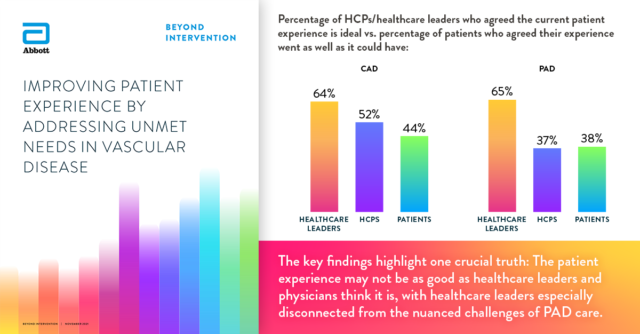
Abbott Vascular is telling HCPs and administrators the cold, hard truth about the patient experience with Beyond Intervention, the medtech’s multiyear global research initiative.
The focus of the report and companion white paper is peripheral artery disease (PAD), coronary artery disease (CAD) and the disconnect between patients’ experience and HCPs and administrators’ views of that experience. Disconnected it is: Around two-thirds (64%) of healthcare leaders and just over (52%) of HCPs believe that patients have a positive experience, while only 44% of CAD patients report they are happy. When it comes to PAD the results are even more grim, with 65% of healthcare leaders thinking it’s gone well, but this was just 37% of HCPs and 38% of patients.
Abbott, which manufactures cardiac and vascular technology, plans to take this information to the real world in a bid to improve the patient experience, especially when it comes to diagnosis of PAD and CAD.
RELATED: An Epic success: FDA approves Abbott’s upgraded , longer-lasting replacement mitral valve
“If you’re a healthcare administrator, this might be a tough message to hear,” Jason Belzer, Abbott’s divisional vice president of U.S. endovascular sales and marketing, said. “But I think so many of the systems do get it right … and more importantly, this was a real partnership. These folks want to continue to understand how to do it better. So even though they may there may be a gap and how they interpret the results. I think there’s an absolute understanding that we all need to do better.”
Belzer talks about taking this information to the streets, so to speak, at the recent VEITHsymposium, the annual conference on vascular and endovascular issues in Orlando, where he used his booth as an opportunity to talk to physicians about the results. Have they experienced them? What are they doing to fix it? And, importantly: What can Abbott do to help?
In addition, the company is getting the information out to its targets with focused media campaigns in various countries and with a very healthy social media presence with Twitter, a strong focus on LinkedIn and a digital plan to spread the word on the white paper.
“This isn’t the Bible that you can come present to a hospital and say, ‘I’m going to solve all your problems,’” Belzer said. “This is a mechanism that allows us to engage in a dialogue with our customer—change the nature of that conversation, change the paradigm, and then figure out where we can insert ourselves in that process.”
RELATED: Abbott elects CEO Ford chairman of the board as predecessor White retires after 40 years
The survey, which was conducted online from April to June 2021, asked 1,800 stakeholders, including 1,289 vascular disease patients, 408 healthcare physicians and 173 healthcare leaders in 13 countries—the U.S., Brazil, Canada, the U.K., France, Germany, Italy, China, Japan, India, Australia, New Zealand and Saudi Arabia—about their experiences.






